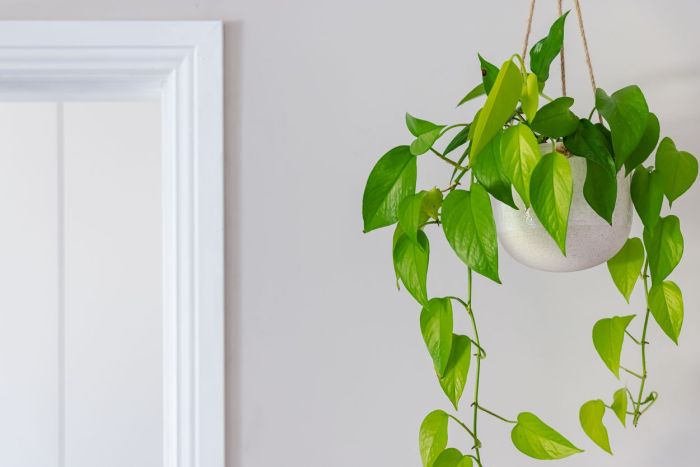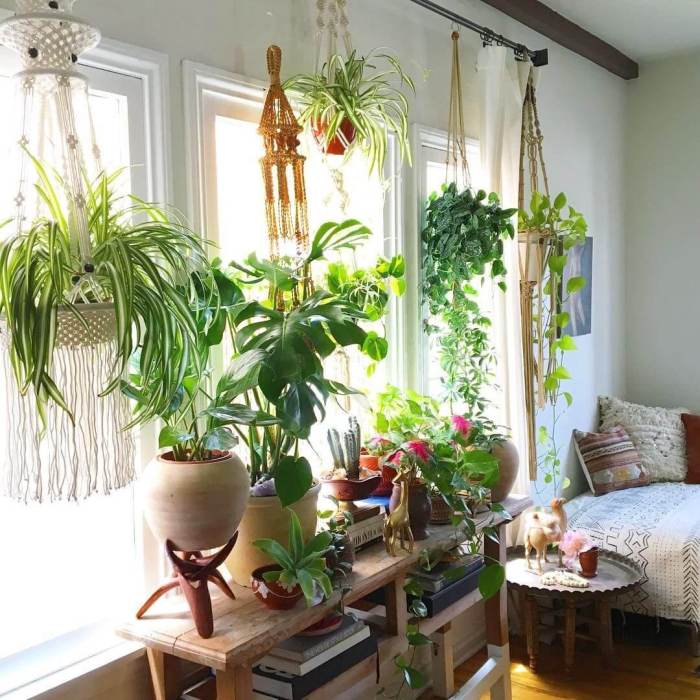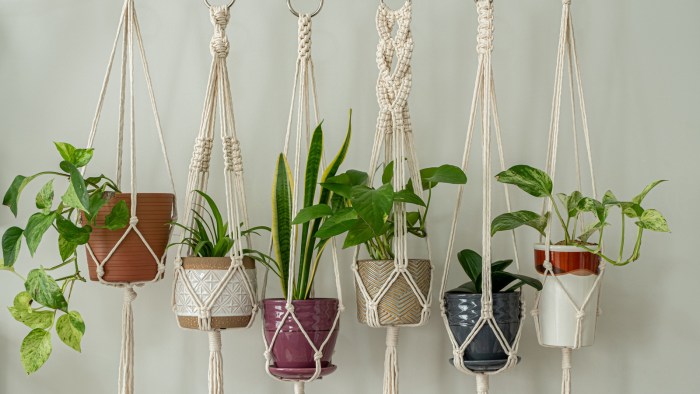Common household hanging plants are a beautiful and versatile way to add life and style to your home. From trailing vines to lush ferns, there is a hanging plant to suit every taste and decor. In this guide, we will explore the different types of common household hanging plants, their ideal growing conditions, care and maintenance tips, and how to incorporate them into your home decor.
Whether you are a seasoned plant enthusiast or just starting out, this guide will provide you with all the information you need to successfully grow and enjoy common household hanging plants.
Types of Common Household Hanging Plants

Hanging plants bring a touch of greenery and natural beauty to any home. They are perfect for adding a pop of color and life to a room, and they can also help to purify the air. There are many different types of hanging plants to choose from, each with its own unique characteristics and appearance.
Popular Hanging Plants
Some of the most popular hanging plants include:
- Spider plant (Chlorophytum comosum): Spider plants are one of the easiest hanging plants to care for. They have long, slender leaves that cascade down from the pot. Spider plants are also known for their ability to produce “spiderettes,” which are small plantlets that can be rooted to create new plants.
- Pothos (Epipremnum aureum): Pothos is another easy-care hanging plant. It has heart-shaped leaves that come in a variety of colors, including green, yellow, and white. Pothos is a fast-growing plant that can quickly fill a pot.
- String of pearls (Senecio rowleyanus): String of pearls is a unique hanging plant that has long, trailing stems that are covered in small, pearl-like leaves. String of pearls is a slow-growing plant that prefers bright, indirect light.
- Burro’s tail (Sedum morganianum): Burro’s tail is a succulent hanging plant that has long, trailing stems that are covered in fleshy, donkey-tail-shaped leaves. Burro’s tail is a drought-tolerant plant that prefers bright, indirect light.
- Air plant (Tillandsia spp.): Air plants are a unique type of hanging plant that does not need soil to grow. They absorb nutrients and moisture from the air. Air plants are available in a variety of shapes and sizes, and they can be used to create beautiful terrariums.
Ideal Growing Conditions for Hanging Plants

Hanging plants add a touch of greenery and elegance to any home. To ensure they thrive, it’s essential to provide them with the optimal growing conditions. This includes meeting their light, temperature, humidity, watering, and drainage needs.
Light Requirements
Different hanging plants have varying light requirements. Some, like ferns and pothos, prefer bright, indirect light. Others, like succulents and cacti, can tolerate full sun or partial shade.
When choosing a location for your hanging plant, consider the amount of natural light it will receive. If your home doesn’t have enough natural light, you may need to supplement with artificial grow lights.
Common household hanging plants like pothos, spider plants, and philodendrons are popular choices for their ability to thrive in various lighting conditions. However, for those seeking the best hanging plants specifically suited for shade indoors, consider exploring best hanging plants for shade indoors . These plants can add a touch of greenery and vibrancy to dimly lit spaces, creating a cozy and inviting atmosphere in your home.
Temperature and Humidity
Most hanging plants prefer temperatures between 65-75°F (18-24°C). Some, like spider plants and peace lilies, can tolerate cooler temperatures. Others, like succulents and cacti, prefer warmer temperatures.
Common household hanging plants, such as ferns, succulents, and ivy, add a touch of greenery and life to any room. For those looking for stylish and functional hanging pots, Bunnings indoor hanging pots offer a wide selection to choose from.
These pots come in various shapes, sizes, and materials, making it easy to find the perfect fit for any indoor space. With the right hanging pot, common household hanging plants can thrive and enhance the overall ambiance of a home.
Humidity is also important for hanging plants. Many prefer high humidity levels, which can be achieved by misting them regularly or placing them on a tray of pebbles filled with water.
Watering and Drainage
Hanging plants should be watered thoroughly when the soil feels dry to the touch. Avoid overwatering, as this can lead to root rot.
Good drainage is also essential. Choose a pot with drainage holes and use a well-draining potting mix to prevent waterlogging.
Care and Maintenance of Hanging Plants

Hanging plants bring a touch of nature and elegance to any home, but they require proper care to thrive. Regular pruning, repotting, and pest and disease management are essential for maintaining their health and beauty.
Pruning
Pruning helps remove dead or overgrown foliage, promotes new growth, and maintains the plant’s desired shape. Use sharp, clean shears to make precise cuts. For trailing plants, pinch off growing tips to encourage bushier growth. For larger plants, remove any stems that are weak, diseased, or growing in an undesirable direction.
Repotting
As hanging plants grow, they may outgrow their pots. Repotting provides fresh soil and more space for root growth. Choose a pot that is slightly larger than the current one, with drainage holes to prevent waterlogging. Use a well-draining potting mix specifically designed for hanging plants.
To repot, carefully remove the plant from its old pot and loosen any tangled roots. Place a layer of fresh potting mix in the new pot and position the plant. Fill the pot with soil, gently firming it around the base of the plant.
Water thoroughly and allow excess water to drain.
Pests and Diseases
Hanging plants are susceptible to various pests and diseases, including aphids, spider mites, mealybugs, and root rot. Regular inspection is crucial for early detection and treatment. If pests are found, use an insecticidal soap or neem oil solution. For root rot, remove the plant from its pot and trim away any affected roots.
Repot the plant in fresh soil and avoid overwatering.
Aesthetic Uses and Design Ideas: Common Household Hanging Plants

Hanging plants have become a popular choice for home decor, adding a touch of greenery and vibrancy to any space. They offer a versatile way to incorporate nature into your home, whether you have limited floor space or simply want to create a more dynamic and inviting atmosphere.
Common household hanging plants are a great way to add life and color to your home. From the popular pothos and spider plants to the more exotic hoyas and ferns, there are many beautiful hanging indoor plants to choose from.
For a comprehensive guide on beautiful hanging indoor plants, visit hangingplantsindoor.com . You’ll find tips on choosing the right plants for your space, how to care for them, and how to create a beautiful hanging display. With a little care, common household hanging plants can thrive and bring years of enjoyment.
One of the key benefits of hanging plants is their ability to create vertical gardens. By suspending plants from the ceiling or walls, you can maximize vertical space and create a lush, cascading effect. This is especially useful in small apartments or rooms where floor space is at a premium.
Vertical Gardens, Common household hanging plants
Vertical gardens can be created using a variety of hanging planters, such as macrame hangers, wire baskets, or wall-mounted planters. You can choose to hang plants individually or group them together to create a more dramatic effect. Consider using a mix of different plant sizes and shapes to add interest and depth to your vertical garden.
Hanging Plant Displays
Hanging plants can also be used to create eye-catching displays. Suspend a group of plants from a ceiling hook or chandelier to create a focal point in a living room or dining room. You can also hang plants from a shelf or windowsill to add a touch of greenery to a workspace or kitchen.
Enhancing Room Styles
Hanging plants can complement a variety of room styles. In a modern or minimalist space, simple and geometric planters can create a clean and sophisticated look. For a more bohemian or eclectic style, choose macrame hangers or woven baskets with intricate patterns.
In a traditional or rustic setting, wooden or metal planters with a vintage or distressed finish can add a touch of warmth and character.
Benefits of Incorporating Hanging Plants

Hanging plants are not only beautiful additions to any home but also provide several benefits for your well-being. These plants can help purify the air, reduce stress, and boost mood.
Air-Purifying Qualities
Certain hanging plants, such as spider plants, peace lilies, and English ivy, have been found to effectively remove harmful toxins from the air. These toxins can come from various sources, including cleaning products, building materials, and even furniture. By incorporating these plants into your home, you can improve the air quality and create a healthier environment for yourself and your family.
Psychological Benefits
Studies have shown that having plants in the home can have a positive impact on our mental health. Plants can help reduce stress, anxiety, and depression. They can also boost mood and creativity. One study found that people who worked in offices with plants had lower levels of stress and higher levels of job satisfaction than those who worked in offices without plants.
Improved Well-being
In addition to their air-purifying and psychological benefits, hanging plants can also improve your overall well-being. They can add a touch of nature to your home, which can be calming and restorative. They can also help you connect with the natural world, which can be beneficial for both your physical and mental health.
Closing Summary
Common household hanging plants are a great way to add beauty and style to your home. They can be used to create vertical gardens, hanging plant displays, and even to enhance different room styles. With proper care and maintenance, these plants can thrive for years to come, bringing you joy and well-being.
FAQ Overview
What are the most popular types of common household hanging plants?
Some of the most popular types of common household hanging plants include pothos, spider plants, philodendrons, ferns, and ivy.
What are the ideal growing conditions for common household hanging plants?
Most common household hanging plants prefer bright indirect light, warm temperatures, and moderate humidity. They should be watered regularly, but allowed to dry out slightly between waterings.
How often should I repot my hanging plants?
Most hanging plants should be repotted every 2-3 years, or when they become rootbound.